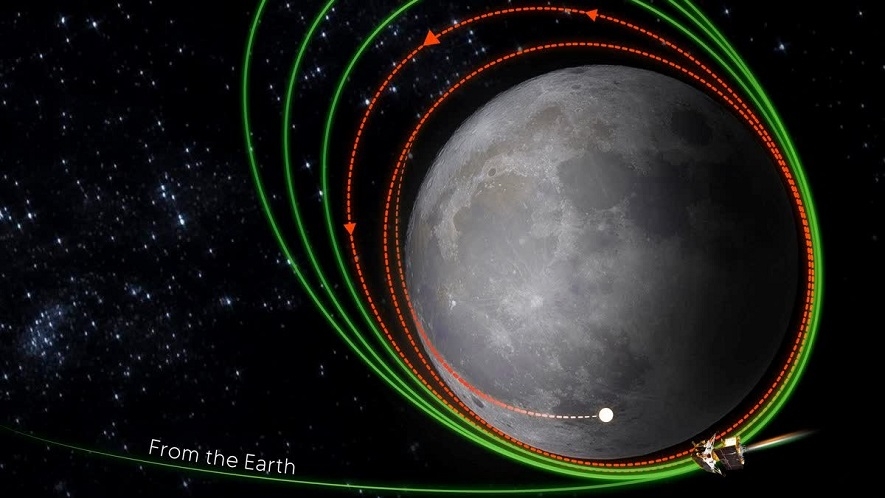Chandrayaan-3 spacecraft achieves near-circular orbit around Moon
15 Aug 2023 07:45:16

BENGALURU :
ISRO gears up for mission to Sun, satellite ADITYA-L1 arrives at Sriharikota for launch
INDIA’S ambitious third Moon mission’s spacecraft Chandrayaan-3 on Monday underwent another manoeuvre, bringing it even closer to the Lunar surface, ISRO said. The national space agency said that the spacecraft has now achieved a “near-circular orbit” around the Moon.
Post its launch on July 14, Chandrayaan-3 entered into the lunar orbit on August 5, following which two orbit reduction manoeuvres were carried out on August 6 and 9.
“Orbit circularisation phase commences. Precise manoeuvre performed today has achieved a near-circular orbit of 150 km x 177 km,” ISRO said in a tweet.
The next operation is planned for August 16, around 8:30 am, it said.
As the mission progresses, a series of manoeuvres is being conducted by ISRO to gradually reduce Chandrayaan-3’s orbit and position it over the lunar poles.
According to ISRO sources, one more manoeuvre will be performed on the spacecraft on August 16 to reach 100 km orbit, following which the landing module, comprising the lander and rover will break away from the propulsion module.
After this, the lander is expected to undergo a “deboost” (the process of slowing down) and make a soft landing on the south polar region of the Moon on August 23.
ISRO gears up for mission to Sun, satellite arrives at Sriharikota for launch: ADITYA-L1, the first space-based Indian observatory to study the Sun, is getting ready for its launch soon, ISRO said on Monday.
The satellite, realised at U R Rao Satellite Centre here, has arrived at the ISRO’s spaceport in Sriharikota in Andhra Pradesh, the Bengaluru-headquartered national space agency said in an update on the mission.
“Mostly September first week,” an ISRO official told PTI when asked about the date of the launch.
The spacecraft is expected to be placed in a halo orbit around the Lagrange point 1 (L1) of the Sun-Earth system, which is about 1.5 million kilometres from the Earth.
A satellite placed in the halo orbit around the L1 point has a major advantage of continuously viewing the Sun without any occultation/eclipses, ISRO noted. “This will provide a greater advantage of observing the solar activities and its effect on space weather in real time,” it said.
The spacecraft carries seven payloads to observe the photosphere, chromosphere and the outermost layers of the Sun (the corona) using electromagnetic and particle and magnetic field detectors.
Using the special vantage point L1, four payloads will directly view the Sun and the remaining three payloads would carry out in-situ studies of particles and fields at the L1, thus providing important scientific studies of the propagatory effect of solar dynamics in the interplanetary medium.
“The suits of Aditya L1 payloads are expected to provide most crucial information to understand the problem of coronal heating, coronal mass ejection, pre-flare and flare activities and their characteristics, dynamics of space weather, propagation of particle and fields etc.,” ISRO said.
The major science objectives of the Aditya-L1 mission are: study of solar upper atmospheric (chromosphere and corona) dynamics; study of chromospheric and coronal heating, physics of the partially ionised plasma, initiation of the coronal mass ejections, and flares; observe the in-situ particle and plasma environment providing data for the study of particle dynamics from the Sun; physics of solar corona and its heating mechanism; diagnostics of the coronal and coronal loops plasma: temperature, velocity and density; development, dynamics and origin of coronal mass ejections; identify the sequence of processes that occur at multiple layers (chromosphere, base and extended corona) which eventually leads to solar eruptive events; magnetic field topology and magnetic field measurements in the solar corona; drivers for space weather (origin, composition and dynamics of solar wind).
The instruments of Aditya-L1 are tuned to observe the solar atmosphere, mainly the chromosphere and corona, while the in-situ instruments will observe the local environment at L1.
Last week, ISRO Chairman S Somnath had said the most critical part of the landing is the process of bringing the velocity of the lander from 30 km height to the final landing, and that the ability to transfer the spacecraft from horizontal to vertical direction is the “trick we have to play” here.
Over five moves in the three weeks since the July 14 launch, ISRO had lifted the Chandrayaan-3 spacecraft into orbits farther and farther away from the Earth.
Chandrayaan-3 is a follow-on mission to Chandrayaan-2 to demonstrate end-to-end capability in safe landing and roving on the lunar surface.
